low beam CHEVROLET EXPRESS 1996 1.G Owners Manual
[x] Cancel search | Manufacturer: CHEVROLET, Model Year: 1996, Model line: EXPRESS, Model: CHEVROLET EXPRESS 1996 1.GPages: 376, PDF Size: 18.83 MB
Page 91 of 376
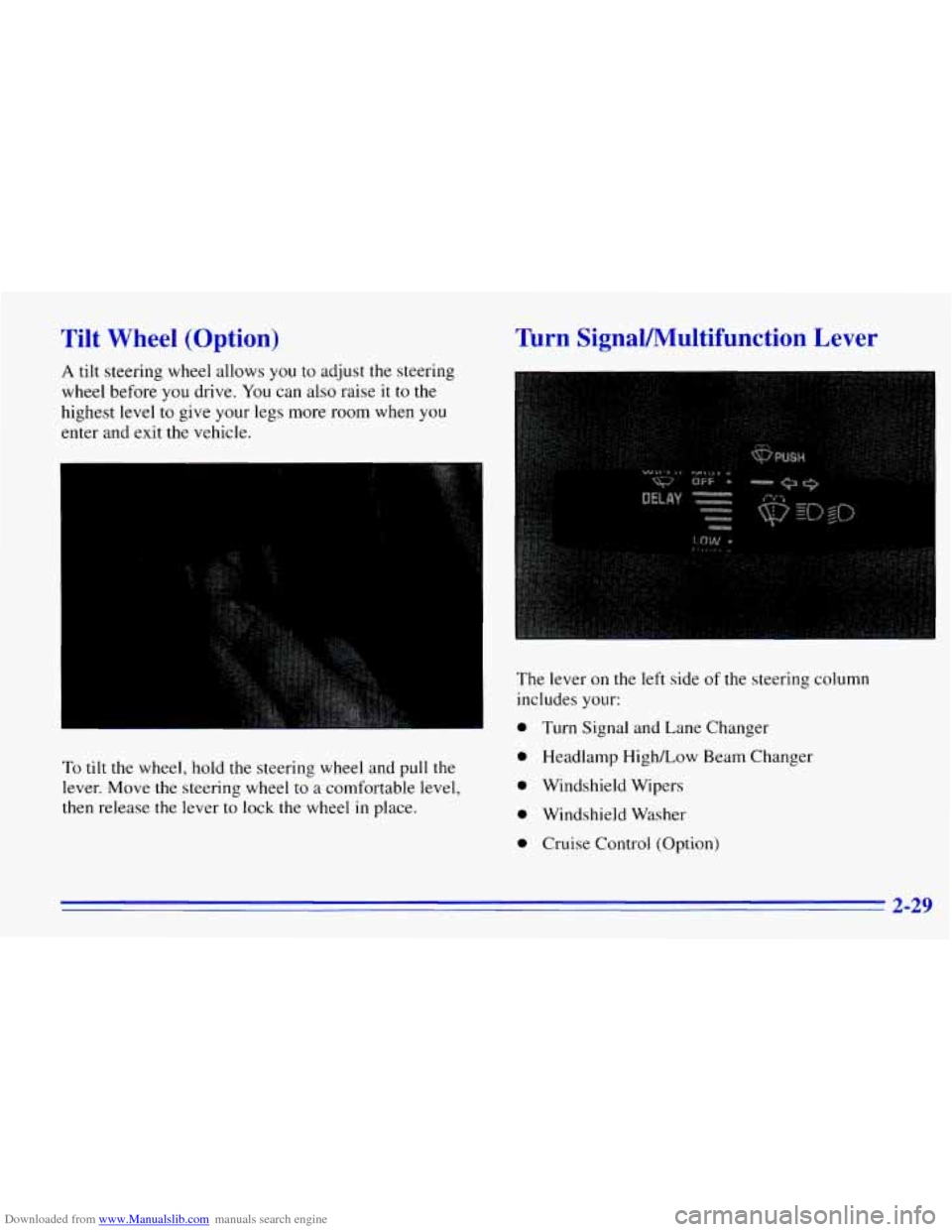
Downloaded from www.Manualslib.com manuals search engine Tilt Wheel (Option)
A tilt steering wheel allows you to adjust the steering
wheel before you drive. You can also raise
it to the
highest level to give your legs more room when you
enter and exit the vehicle.
To tilt the wheel, hold the steering wheel and pull the
lever. Move the steering wheel
to a comfortable level,
then release the lever to lock the wheel
in place.
Turn SignaVMultifunction Lever
The lever on the left side of the steering column
includes your:
0 Turn Signal and Lane Changer
0 Headlamp High/Low Beam Changer
0 Windshield Wipers
0 Windshield Washer
0 Cruise Control (Option)
2-29
Page 92 of 376
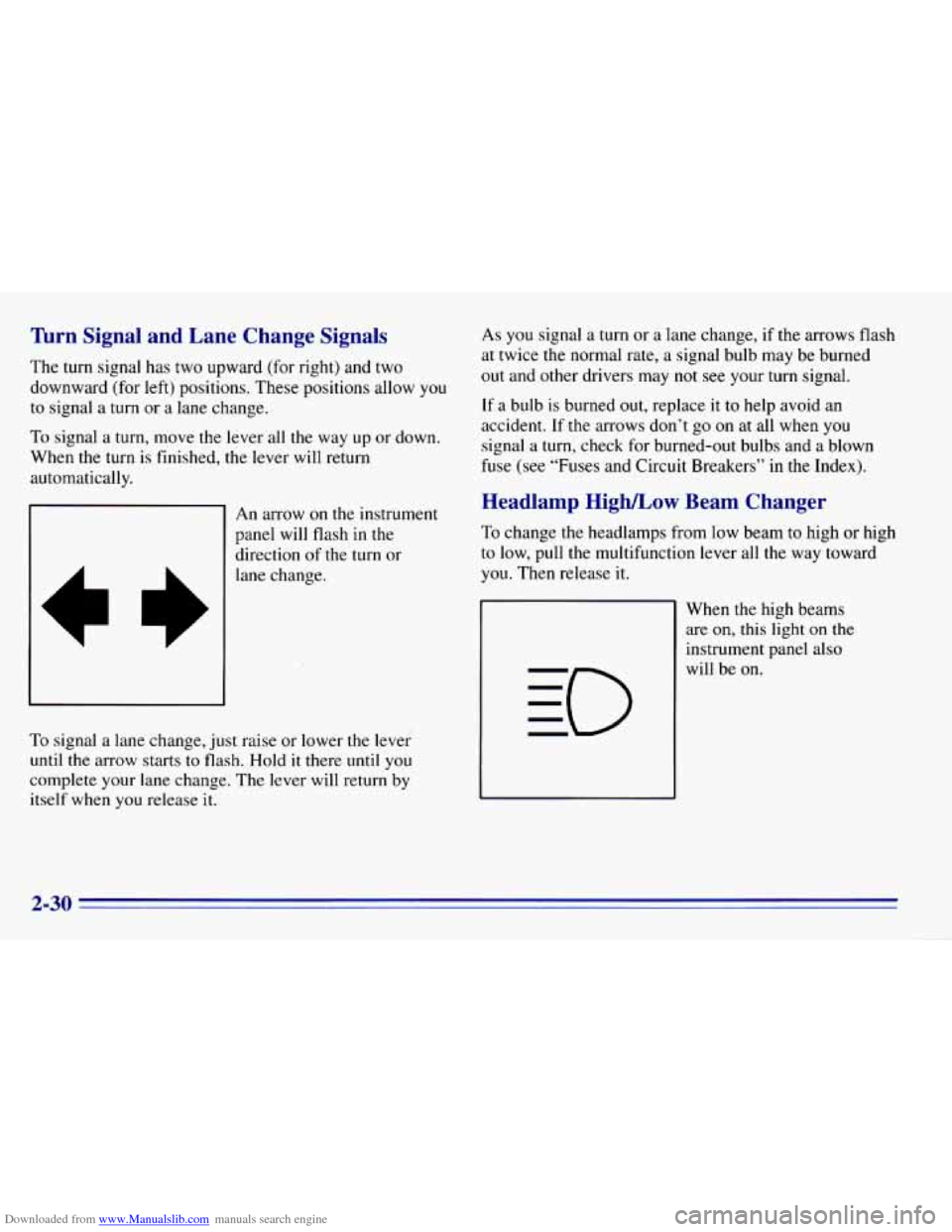
Downloaded from www.Manualslib.com manuals search engine ’hrn Signal and Lane Change Signals
The turn signal has two upward (for right) and two
downward (for left) positions. These positions allow
you
to signal a turn or a lane change.
To signal
a turn, move the lever all the way up or down.
When the turn is finished, the lever will return
automatically.
An arrow on the instrument
panel will flash in the
direction of the turn or
lane change.
To signal a lane change, just raise or lower the lever
until
the arrow starts to flash. Hold it there until you
complete your lane change. The lever will return by
itself when
you release it. As
you signal
a turn or a lane change, if the arrows flash
at twice the normal rate, a signal bulb may be burned
out and other drivers may not see your turn signal.
If a bulb is burned out, replace it to help avoid an
accident. If.the arrows don’t go on at all when
you
signal a turn, check for burned-out bulbs and a blown
fuse (see “Fuses and Circuit Breakers” in the Index).
Headlamp High/Low Beam Changer
To change the headlamps from low beam to high or high
to low, pull the multifunction lever all the way toward
you. Then release it.
When the high beams are
on, this light on the
instrument panel also
will be on.
2-30
.-
Page 98 of 376
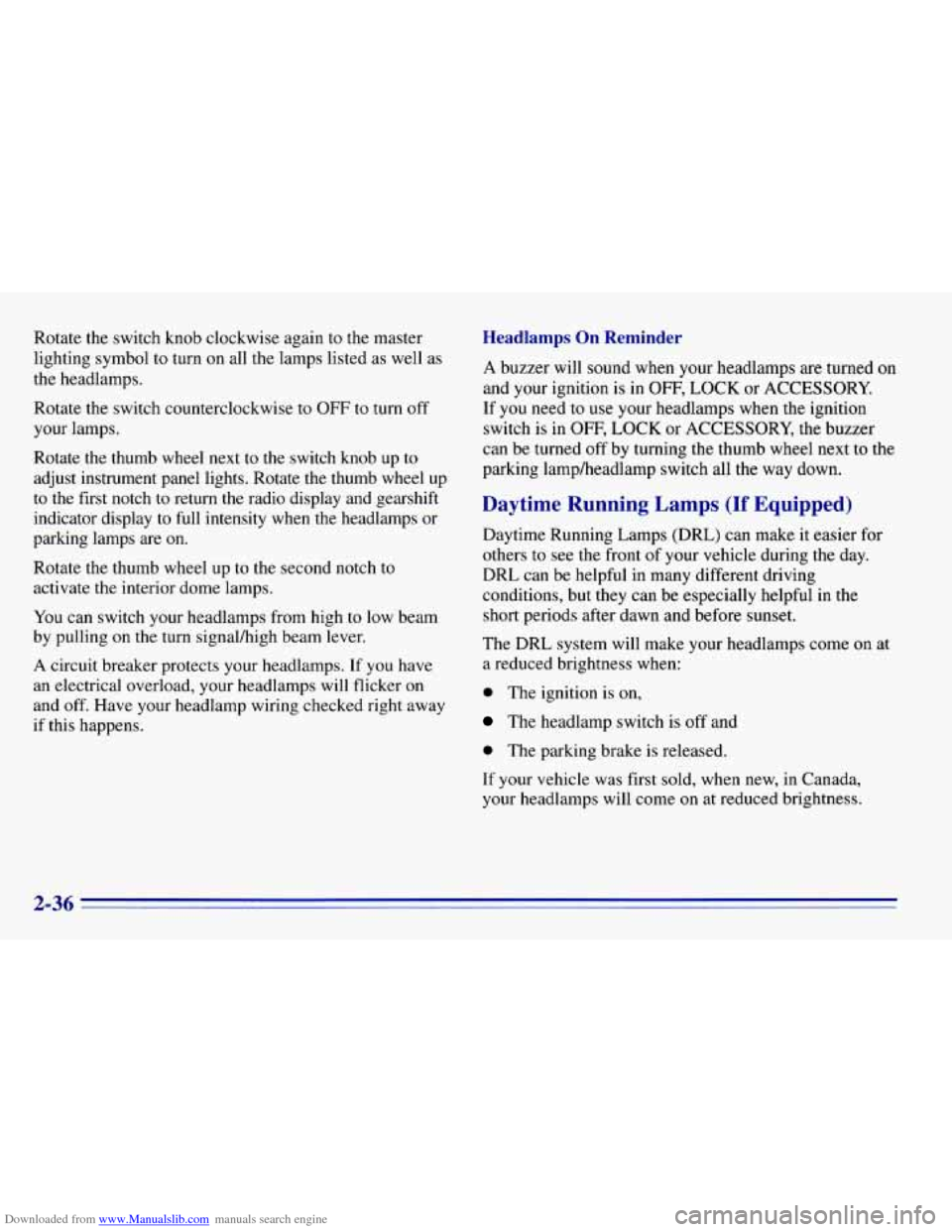
Downloaded from www.Manualslib.com manuals search engine Rotate the switch knob clockwise again to the master
lighting symbol
to turn on all the lamps listed as well as
the headlamps.
Rotate the switch counterclockwise to
OFF to turn off
your lamps.
Rotate the thumb wheel next
to the switch knob up to
adjust instrument panel lights. Rotate the thumb wheel up
to the first notch to return the radio display and gearshift
indicator display
to full intensity when the headlamps or
parking lamps are
on.
Rotate the thumb wheel up to the second notch to
activate the interior dome lamps.
You can switch your headlamps from high to low beam
by pulling
on the turn signalhigh beam lever.
A circuit breaker protects your headlamps. If you have
an electrical overload, your headlamps will flicker on
and off. Have your headlamp wiring checked right away
if this happens.
Headlamps On Reminder
A buzzer will sound when your headlamps are turned on
and your ignition is in OFF, LOCK or ACCESSORY.
If
you need to use your headlamps when the ignition
switch is in
OFF, LOCK or ACCESSORY, the buzzer
can be turned off by turning the thumb wheel next to the
parking lampheadlamp switch all the way down.
Daytime Running Lamps (If Equipped)
Daytime Running Lamps (DRL) can make it easier for
others
to see the front of your vehicle during the day.
DRL can be helpful in many different driving
conditions, but they can be especially helpful in the
short periods after dawn and before sunset.
The DRL system will make your headlamps come
on at
a reduced brightness when:
0 The ignition is on,
The headlamp switch is off and
0 The parking brake is released.
If your vehicle was first sold, when new, in Canada,
your headlamps will come
on at reduced brightness.
2-36
Page 99 of 376
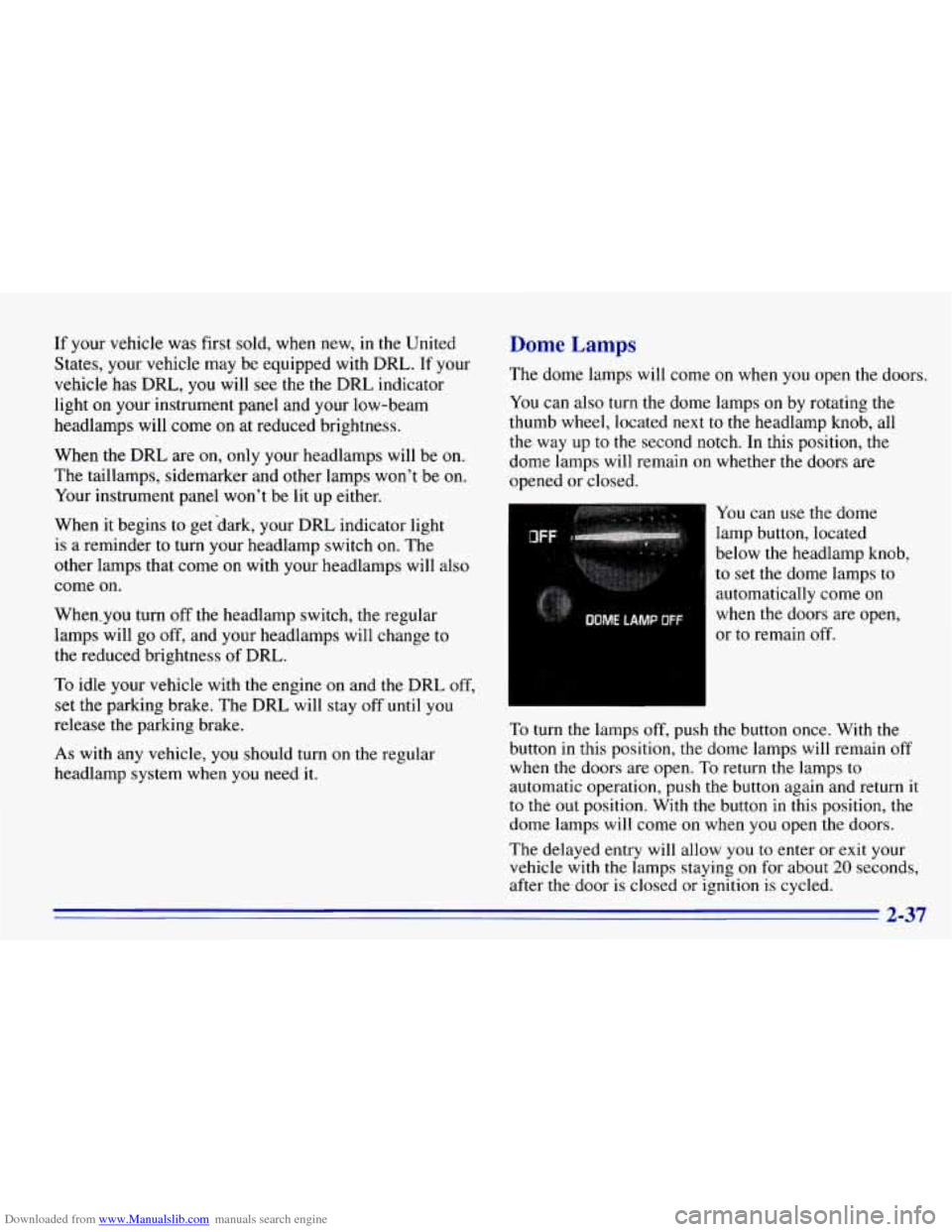
Downloaded from www.Manualslib.com manuals search engine If your vehicle was first sold, when new, in the United
States, your vehicle may be equipped with DRL. If your
vehicle has DRL,
you will see the the DRL indicator
light
on your instrument panel and your low-beam
headlamps will come
on at reduced brightness.
When the DRL are on, only your headlamps will be on.
The taillamps, sidemarker and other lamps won’t be on.
Your instrument panel won’t be lit up either,
When it begins to get dark, your DRL indicator light
is a reminder
to turn your headlamp switch on. The
other lamps that come on with your headlamps will also
come on.
When-you turn off the headlamp switch, the regular
lamps will go
off, and your headlamps will change to
the reduced brightness of DRL.
To idle your vehicle with the engine on and the DRL
off,
set the parking brake. The DRL will stay off until you
release the parking brake.
As with any vehicle, you should turn on the regular
headlamp system when you need it.
Dome Lamps
The dome lamps will come on when you open the doors.
You can also turn the dome lamps on by rotating the
thumb wheel, located next
to the headlamp knob, all
the way up
to the second notch. In this position, the
dome lamps will remain on whether the doors are
opened or closed.
You can use the dome
lamp button, located
below the headlamp knob,
to set the dome lamps to
automatically come
on
when the doors are open,
or to remain off.
To turn
the lamps off, push the button once. With the
button in this position, the dome lamps will remain off
when the doors are open. To return the lamps
to
automatic operation, push the button again and return it
to the out position. With the button in this position, the
dome lamps will come
on when you open the doors.
The delayed entry will allow you
to enter or exit your
vehicle with the lamps staying
on for about 20 seconds,
after the door is closed
or ignition is cycled.
2-37
Page 166 of 376

Downloaded from www.Manualslib.com manuals search engine Here are some tips on night driving.
0
0
0
0
0
0
0
Drive defensively.
Don’t drink and drive.
Adjust your inside rearview mirror to reduce the
glare from headlamps behind you.
Since you can’t see as well, you may need to
slow down and keep more space between
you
and other vehicles.
Slow down, especially on higher speed roads.
Your
headlamps can light up only so much road ahead.
In remote areas, watch for animals.
If you’re tired, pull off the road in a safe place
and rest.
Night Vision
No one can see as well at night as in the daytime. But as
we get older these differences increase.
A 50-year-old
driver may require at least twice
as much light to see the
same thing at night as a 20-year-old.
What you do
in the daytime can also affect your night
vision. For example,
if you spend the day in bright
sunshine
you are wise to wear sunglasses. Your eyes will have less trouble adjusting
to night. But if you’re
driving, don’t wear sunglasses at night. They may cut
down
on glare from headlamps, but they also make a
lot of things invisible.
You can be temporarily blinded by approaching
headlamps.
It can take a second or two, or even several
seconds, for your eyes to readjust to
the dark. When you
are faced
with severe glare (as from a driver who
doesn’t lower the high beams, or
a vehicle with
misaimed headlamps), slow down a little. Avoid staring
directly into the approaching headlamps.
Keep your windshield and all the glass on your vehicle
clean
-- inside and out. Glare at night is made much
worse by dirt on the glass. Even the inside of the glass
can build up a film caused by dust. Dirty glass makes
lights dazzle and flash more than clean glass would,
making the pupils
of your eyes contract repeatedly.
Remember that your headlamps light up far less
of a
roadway when you are in a turn or curve. Keep your
eyes moving; that way, it’s easier to pick out dimly
lighted objects. Just as your headlamps should be
checked regularly for proper aim,
so should your eyes
be examined regularly. Some drivers suffer from night
blindness
-- the inability to see in dim light -- and aren’t
even aware
of it.
4-14
Page 169 of 376

Downloaded from www.Manualslib.com manuals search engine Hydroplaning
Hydroplaning is dangerous. So much water can build up
under your tires that they can actually ride on the water.
This can happen if the road is wet enough and you’re
going fast enough. When your vehicle
is hydroplaning,
it has little or no contact with the road.
Hydroplaning doesn’t happen often. But it can
if your
tires haven’t much tread or if the pressure in one or
more is low. It can happen if a lot of water is standing on
the road. If you can see reflections from trees, telephone
poles or other vehicles, and raindrops “dimple” the
water’s surface, there could be hydroplaning.
Hydroplaning usually happens at higher speeds. There
just isn’t a hard and fast rule about hydroplaning. The
best advice is to slow down when it
is raining.
Driving Through Deep Standing Water
I
NOTICE:
If you drive too quickly through deep puddles
or standing water, water can come
in through
your engine’s air intake and badly damage your
engine. Never drive through water that is slightly
lower than the underbody
of your vehicle. If you
can’t avoid deep puddles or standing water, drive
through them very slowly.
Some Other Rainy Weather Tips
0
0 Turn on your low-beam headlamps -- not just
your parking lamps
-- to help make you more
visible to others.
Besides slowing down, allow some extra following
distance. And be especially careful when you pass
another vehicle. Allow yourself more clear room
ahead, and
be prepared to have your view restricted
by road spray.
Have good tires with proper tread depth. (See
“Tires” in the Index.)
4-17
Page 259 of 376

Downloaded from www.Manualslib.com manuals search engine i
A CAUTION:
Batteries have acid that can burn you ana gas
that can explode. You can be badly hurt if you
aren’t careful. See “Jump Starting” in the Index
for tips on working around a battery without
getting hurt.
Contact your dealer to learn how to prepare your vehicle
for longer storage periods.
Also, for your audio system, see “Theft-Deterrent
Feature”
in the Index.
Bulb Replacement
Before you replace any bulbs, be sure that all the lamps
are
off and the engine isn’t running. See “Replacement
Bulbs”
in the index for the proper types of bulbs to use.
Halogen Bulbs
’ A CAUTION: I I
Halogen bulbs have pressurized gas inside and
can burst if you drop
or scratch the bulb. You or
others could be injured. Be sure to read and
follow the instructions on the bulb package.
I
Headlamps
You have either a sealed beam headlamp system or a
composite system.
6-3 1
Page 297 of 376
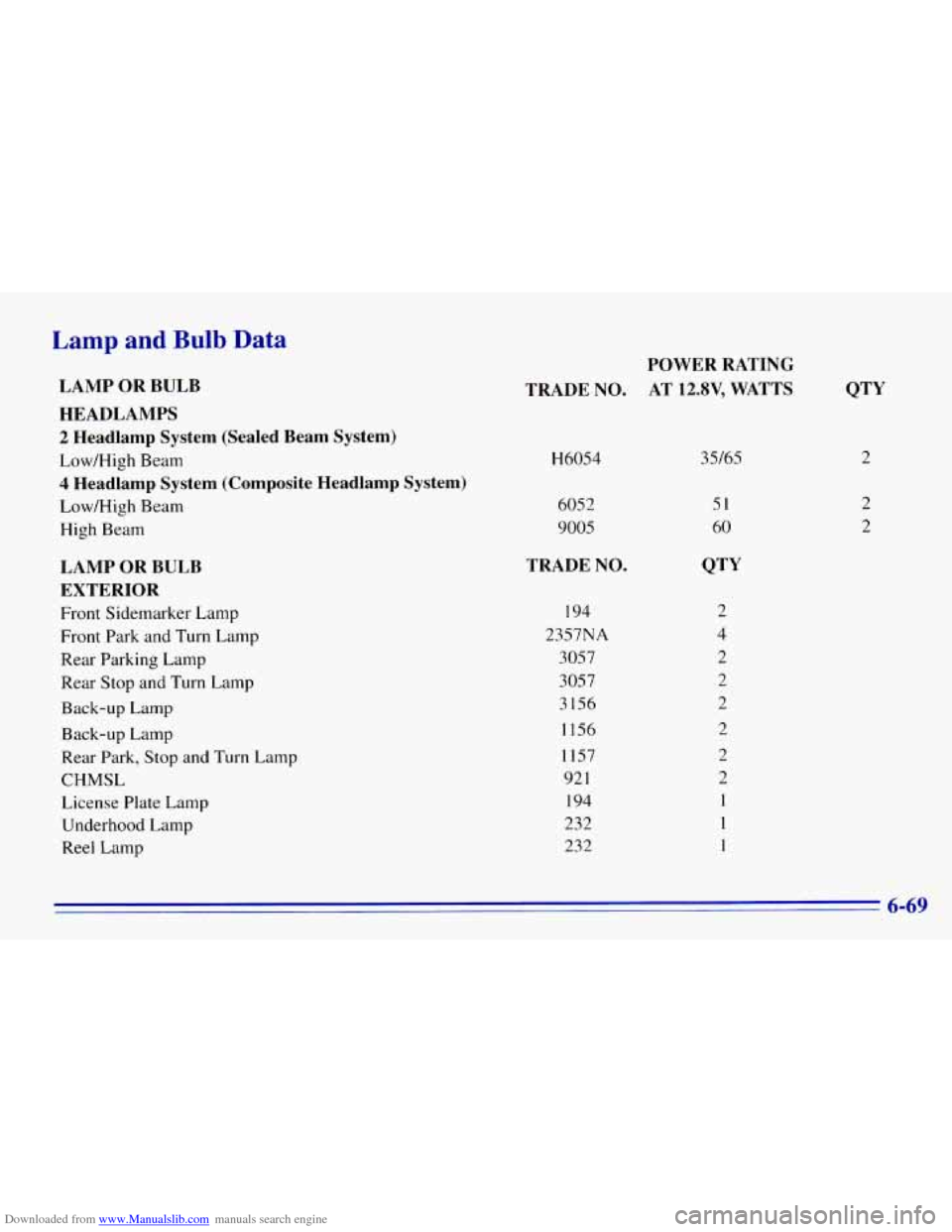
Downloaded from www.Manualslib.com manuals search engine Lamp and Bulb Data
LAMP OR BULB
HEADLAMPS
2 Headlamp System (Sealed Beam System)
Low/High Beam
4 Headlamp System (Composite Headlamp System)
Low/High Beam
High Beam
LAMP OR BULB
EXTERIOR
Front Sidemarker Lamp
Front Park and Turn Lamp
Rear Parking Lamp
Rear Stop and Turn
Lamp
Back-up Lamp
Back-up Lamp
Rear Park, Stop and Turn
Lamp
CHMSL
License Plate Lamp
Underhood
Lamp
Reel Lamp
POWER RATING
TRADE NO. AT
12.8V, WATTS
H6054
6052
9005
TRADE NO.
194
2357NA
3057
3057
3156
1156
1157
92 1
I94
232
232
35/65
51
60
2
4
2
2
2
6-69
Page 368 of 376

Downloaded from www.Manualslib.com manuals search engine Engine ........................................ 6-8
Coolant
..................................... 6-20
Coolant Level Check
.......................... 7-43
Coolant Temperature Gage
..................... 2-54
Cooling System
.............................. 6-66
Exhaust
..................................... 2-24
Identification
........................... 6-60. 6-65
OilLevelCheck
.............................. 7-43
Overheating
................................. 5- 10
Running While Parked ......................... 2-25
StartingYour
................................ 2-14
Engineoil
.................................... 6-11
Additives ................................... 6-13
Checking
................................... 6-11
Pressure Gage
................................ 2-52
Used
....................................... 6-14
Whentochange
.............................. 6-14
Ethanol
........................................ 6-3
Exhaust, Engine
................................ 2-24
Fabric Cleaning
............................... 6-5 I
Fan Control, Climate Control System ................ 3-2
FillingYourTank
................................ 6-4
Filter, Air
..................................... 6-15
Finish Care
.................................... 6-56
Finish Damage ................................. 6-57
First Gear, Automatic Transmission
................ 2- I9
Flashers, Hazard Warning ......................... 5-1
Flat Tire. Changing
............................. 5-20
Fluid Capacities
................................ 6-65
Fluids and Lubricants
............................ 7-49
Foreign Countries, Fuel
........................... 6-4
Adding ..................................... 6-11
French Language Manual 11
Front Parkingflurn Signal Lamp Bulb Replacement .... 6-34
Front Storage Area
.............................. 2-41
FrontTowing
................................... 5-8
Fuel .......................................... 6-2
Canada
...................................... 6-3
Filling Your Tank
.............................. 6-4
Gage
....................................... 2-53
In Foreign Countries ........................... 6-4
Tank Capacity
............................... 6-67
Fuses and Circuit Breakers
....................... 6-62
Gages
.. ...........................
Engine Coolant Temperature .................... 2-54
Engine Oil Pressure
........................... 2-52
Fuel
....................................... 2-53
Speedometer
................................. 2-45
Voltmeter
................................... 2-55
Gear Positions. Automatic Transmission
............. 2-17
Gross Axle Weight Rating
........................ 4-27
Gross Vehicle Weight Rating
...................... 4-26
Guide en Franpis
11
GAWR ....................................... 4-27
.. .................................
GVWR ....................................... 4-26
Halogen
Bulbs ................................ 6-31
Hazard Warning Flashers .......................... 5-1
Head Restraints
................................. 1-5
Headlamps
.................................... 2-35
Bulb Replacement
............................ 6-31
HighLow Beam Changer ...................... 2-30
OnReminder
................................ 2-36
Wiring
..................................... 6-61
9-4